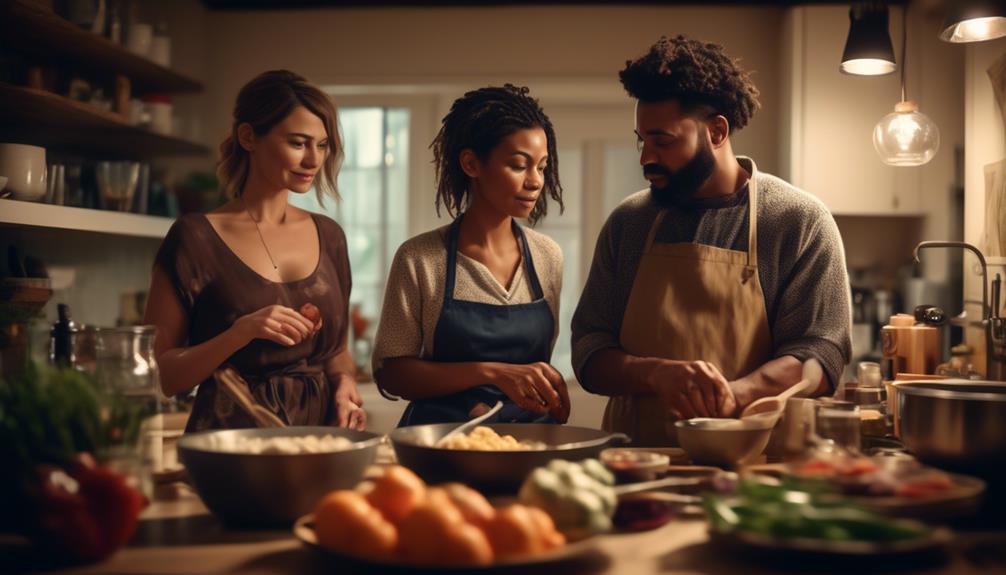How to Address Cultural Differences in Everyday Marriage Life

Addressing cultural differences in everyday marriage life is a challenge that requires embracing the unknown. It involves being willing to navigate gender roles, traditions, and the uncharted territory of cultural diversity.
Navigating gender roles can be particularly challenging, as different cultures may have different expectations for husbands and wives. In some cultures, the husband may be expected to be the breadwinner and make all the major decisions, while the wife may be expected to take care of the household chores and children. In other cultures, there may be more equality in the division of labor and decision-making.
Traditions also play a significant role in marriage life. Each culture has its own set of traditions and customs that are often deeply ingrained in people's lives. These traditions can affect various aspects of marriage, such as wedding ceremonies, family dynamics, and even daily routines. Understanding and respecting these traditions is essential for a harmonious marriage.
Cultural diversity adds another layer of complexity to addressing cultural differences in marriage life. When individuals from different cultural backgrounds come together in marriage, they bring with them their unique values, beliefs, and practices. This can lead to clashes and misunderstandings if not handled with sensitivity and open-mindedness.
Overall, addressing cultural differences in everyday marriage life requires a willingness to learn, adapt, and compromise. It involves actively seeking to understand and appreciate each other's cultural backgrounds, while also finding common ground and creating new traditions that reflect the unique blend of cultures in the relationship. By embracing the unknown and celebrating diversity, couples can build a strong and resilient marriage that transcends cultural boundaries.
Recognizing and Embracing Cultural Diversity
Recognize and embrace cultural diversity to foster a more inclusive and enlightened marriage life. In today's world, it's imperative to acknowledge and appreciate the beauty of different cultures. Building intercultural friendships and participating in multicultural celebrations can enrich your marriage in ways you never imagined.
By embracing cultural diversity, you open yourself up to new perspectives, ideas, and experiences. This can lead to a deeper understanding and appreciation of your partner's background and heritage. It allows you to break free from narrow-mindedness and expand your horizons.
Intercultural friendships play a crucial role in building a strong foundation for your marriage. These friendships expose you to different customs, traditions, and ways of life. They challenge your preconceived notions and help you grow as an individual and as a couple. By surrounding yourself with diverse friends, you create a supportive network that celebrates and respects cultural differences.
Participating in multicultural celebrations is another way to embrace cultural diversity within your marriage. Attending festivals, trying different cuisines, and engaging in cultural activities can be incredibly enriching. It allows you to celebrate and honor the traditions of your partner, fostering a sense of unity and togetherness.
Effective Communication in Cross-Cultural Relationships
To effectively navigate cross-cultural relationships, you must prioritize open and direct communication, leaving no room for misunderstandings or assumptions. In intercultural relationships, effective communication is even more crucial as it helps in bridging differences and promoting understanding between partners.
Here are three key aspects of effective communication in cross-cultural relationships:
- Be explicit: Clearly articulate your thoughts, feelings, and expectations to your partner. Avoid assumptions or expecting them to understand your cultural perspective without explanation. Be willing to explain your cultural background and beliefs, and encourage your partner to do the same.
- Active listening: Listening isn't just about hearing the words, but also about understanding the underlying emotions and cultural context. Practice active listening by giving your partner your full attention, asking clarifying questions, and empathizing with their perspective.
- Adapt and compromise: Recognize that both partners come from different cultural backgrounds and may have different communication styles. Be open to adapting your communication approach to accommodate your partner's preferences. Find common ground and be willing to compromise when conflicts arise.
You think you're entitled to traditional gender roles and expectations in your marriage?
Think again.
Cultural norms and values vary greatly around the world, and what you consider normal may be completely different in another culture.
In order to navigate these differences, effective communication and compromise are essential.
Gender Role Expectations
Navigating the complexities of gender roles and expectations in marriage requires open and honest communication. It's important to explore traditional roles and challenge gender stereotypes to create a healthy and balanced relationship. Here are three key points to consider:
- Break free from societal expectations: Question the traditional gender roles that society imposes on you and your partner. Discuss and challenge these expectations to find a balance that works for both of you.
- Share responsibilities equally: In a modern marriage, it's crucial to divide household chores, child-rearing, and financial responsibilities equally. This promotes a sense of equality and reduces the burden on one partner.
- Embrace individual strengths: Recognize and appreciate each other's unique abilities and strengths, regardless of gender. Encourage each other to pursue personal and professional goals, and support one another in achieving them.
Cultural Norms and Values
Challenging societal expectations and gender stereotypes in marriage also means navigating the differences in cultural norms and values. Recognizing cultural practices and maintaining cultural sensitivity in relationships is crucial to successfully bridging these gaps.
It requires a willingness to let go of preconceived notions and embrace the values and traditions of your partner's culture. This means being open to new ways of doing things and understanding that there's no one-size-fits-all approach to marriage. It may involve adjusting your own beliefs and behaviors to align with your partner's cultural expectations.
However, it's important to strike a balance and ensure that both partners' values and needs are respected. Navigating cultural differences requires patience, empathy, and a genuine desire to understand and appreciate each other's backgrounds.
Communication and Compromise
Understanding and adapting to different gender roles and expectations is essential in navigating cultural differences in marriage. When it comes to communication and compromise, there are several key factors to consider:
1) Communication barriers: Cultural differences can create communication barriers, making it challenging to express thoughts and feelings effectively. Recognize these barriers and strive to find common ground through active listening and open-mindedness.
2) Compromising cultural traditions: In a multicultural marriage, both partners may have different cultural traditions and practices. It's crucial to find a middle ground where both partners can compromise and respect each other's cultural backgrounds. This may involve adjusting certain traditions or finding new ways to incorporate both cultures into daily life.
3) Embrace change and growth: Cultural differences can be an opportunity for personal growth and understanding. Embrace the chance to learn from each other's perspectives and be open to change. Remember, compromise doesn't mean giving up your identity but finding harmony in your differences.
Balancing Traditions and Creating New Customs
You've heard it before: 'When two cultures come together, traditions clash.' But what if we challenge that notion?
Balancing traditions and creating new customs in a marriage can be an opportunity for cultural blending and embracing diversity.
Rather than seeing differences as obstacles, why not see them as a chance to create a unique and vibrant union that celebrates the richness of both backgrounds?
Cultural Blending
Sometimes, blending cultural traditions in a marriage can be a delicate and contentious process. It requires finding a balance between honoring each other's backgrounds and creating new customs that reflect your shared identity. Here are three key considerations for cultural blending in marriage:
- Cultural assimilation: It's important to acknowledge that both partners may have different expectations when it comes to assimilating into each other's cultures. It's crucial to have open and honest conversations about how much assimilation is expected and find a compromise that respects both individuals.
- Cross-cultural parenting: When raising children, it becomes even more important to navigate cultural differences. It's vital to create an environment where children can appreciate and understand both cultures, encouraging open discussions and providing exposure to traditions from both sides.
- Creating new customs: Blending cultures allows for the creation of unique customs that reflect your shared identity. Embrace the opportunity to create new traditions that incorporate aspects from both cultures, ensuring that they're meaningful and inclusive for both partners.
Embracing Diversity
Embrace the challenge of blending traditions while creating new customs that reflect your shared identity.
In intercultural relationships, it's crucial to have an empathetic understanding of each other's backgrounds and beliefs.
Balancing traditions can be a delicate task, but it's essential to find a middle ground that respects both cultures.
It isn't about erasing one's heritage, but rather about embracing the diversity and creating new customs together.
This process requires open communication and a willingness to compromise.
It's controversial to challenge the norms and expectations of each culture, but it's necessary for the growth of your relationship.
Resolving Conflict in a Culturally Sensitive Manner
Resolving conflict in a culturally sensitive manner requires open communication and a willingness to understand and respect each other's perspectives. When it comes to addressing conflicts in your multicultural marriage, here are three essential steps to consider:
- Practice active listening: Conflict resolution techniques such as active listening can help you truly understand your partner's point of view. Instead of interrupting or jumping to conclusions, listen attentively and empathetically. This approach allows you to acknowledge their feelings and concerns, fostering a more constructive conversation.
- Seek cultural sensitivity training: Cultural sensitivity training can provide valuable insights into understanding and appreciating different cultural backgrounds. By educating yourselves about each other's customs, traditions, and values, you can navigate conflicts more effectively. This training helps build empathy and promotes mutual respect, allowing you to find common ground and resolve conflicts in a way that honors both cultures.
- Embrace compromise: In any relationship, compromise is crucial. This is especially true in a multicultural marriage, where different cultural expectations and norms may clash. Finding a middle ground that respects both partners' cultural backgrounds is essential for resolving conflicts. By compromising and finding alternative solutions, you can ensure that neither culture is compromised and that both partners feel heard and valued.
Resolving conflict in a culturally sensitive manner requires effort and understanding from both partners. By implementing these steps, you can create a harmonious and respectful environment where conflicts can be resolved in a way that upholds both individuals' cultural identities.
In a multicultural marriage, forging a shared identity requires a deliberate and conscious effort from both partners. It is essential to create a solid foundation based on shared experiences and intercultural understanding. This will help you navigate the challenges that arise from merging two different cultural backgrounds.
To build a shared identity, it is crucial to embrace open and honest communication. Discuss your individual values, beliefs, and traditions, and find ways to incorporate them into your shared life. By doing so, you can create a unique blend of cultures that honors both your backgrounds.
Another effective strategy is to actively seek out shared experiences. This could involve participating in cultural events together, exploring new cuisines, or learning each other's languages. By immersing yourselves in each other's cultures, you can develop a deeper understanding and appreciation for one another.
To assist you in building a shared identity, consider the following table:
| Shared Experiences | Intercultural Understanding |
|---|---|
| Attending cultural festivals | Learning about each other's customs and traditions |
| Cooking traditional meals together | Discussing the significance of certain rituals |
| Traveling to each other's home countries | Engaging in activities that celebrate both cultures |
Seeking Support From Family and Community
To navigate the challenges of a multicultural marriage, seeking support from family and community is crucial. Here are three reasons why you should prioritize family support and community involvement:
- Family support: Your family can provide a valuable support system during difficult times. They can offer guidance, advice, and a listening ear when you need it most. By involving your family in your multicultural marriage, you can create a sense of unity and understanding between your partner and your loved ones. This can help bridge the cultural gap and foster a more harmonious relationship.
- Community involvement: Engaging with your local community can provide a sense of belonging and connection. It allows you and your partner to meet other couples who may have faced similar challenges in their multicultural marriages. By participating in community events, workshops, or support groups, you can gain valuable insights, share experiences, and develop a network of individuals who can offer guidance and encouragement.
- Shared experiences: By seeking support from family and community, you can expose yourself and your partner to a wider range of experiences and perspectives. This can help you both grow individually and as a couple. It can also foster a sense of cultural appreciation and understanding, as you learn from others who've navigated the complexities of multicultural marriages.
Continual Learning and Growth in Cultural Understanding
Engaging in continual learning and growth is essential for developing cultural understanding in your multicultural marriage. It's not enough to simply acknowledge and accept cultural differences; you must actively seek opportunities for cultural immersion and strive for intercultural competence.
Cultural immersion means fully immersing yourself in your partner's culture. This could involve attending cultural events, participating in traditional rituals, or even learning the language. By immersing yourself in your partner's culture, you gain a deeper understanding and appreciation for their values, beliefs, and customs. This won't only strengthen your bond with your partner but also foster a sense of respect and appreciation for their cultural heritage.
Intercultural competence goes beyond mere tolerance of cultural differences. It means actively developing the skills and knowledge necessary to navigate and communicate effectively in a multicultural setting. This involves learning about different communication styles, understanding cultural norms and expectations, and being open to challenging your own assumptions and biases.
Continual learning and growth in cultural understanding requires effort and commitment. It may involve stepping out of your comfort zone, facing uncomfortable situations, and even making mistakes. However, the rewards are invaluable.
Frequently Asked Questions
To navigate the challenges of cultural differences in everyday marriage life, you need strategies for communication and a willingness to compromise. It's important to understand and respect each other's cultural backgrounds to create a harmonious and fulfilling relationship.
What Are Some Effective Strategies for Resolving Conflicts in a Culturally Sensitive Manner?
When it comes to resolving conflicts in a culturally sensitive manner, you need effective strategies. Use conflict resolution techniques like active listening and compromise. Communication strategies such as empathy and open dialogue are essential.
How Can I Balance My Own Cultural Traditions With Creating New Customs in My Multicultural Marriage?
To balance your cultural traditions and create new customs in your multicultural marriage, embrace change. Be open to learning and understanding your partner's traditions, while also finding ways to incorporate and honor your own. It's a delicate dance, but worth it.
To build a shared identity in a multicultural marriage, celebrate diversity by embracing and appreciating each other's cultural backgrounds. Create a harmonious fusion by blending traditions to form a unique and inclusive identity.
Where Can I Seek Support From Family and Community in Addressing Cultural Differences in My Marriage?
You can seek support from family and community in addressing cultural differences in your marriage. They can provide guidance, understanding, and resources that will help navigate the challenges and create a stronger bond.











